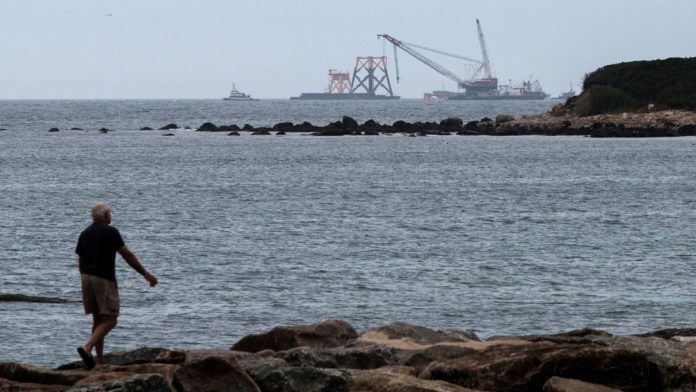
NEW YORK – High winds and expensive electricity make Block Island a good site for the first U.S. offshore wind farm. For the same reasons, Long Island may be next.
Deepwater Wind LLC last week began towing the first of five massive steel frameworks to a site off Rhode Island’s Atlantic coast. When complete next year, the 30-megawatt wind farm will sell power for 24.4 cents a kilowatt-hour.
While that’s almost triple the 8.5-cent levelized cost for wind turbines installed on land, the project is expected to lower electricity rates by 40 percent for residents of Block Island, a popular vacation destination that’s powered primarily with imported diesel fuel.
“You’ve got a unique situation with Block Island,” said Jim Bennett, renewable energy program manager at the Bureau of Ocean Energy Management, the U.S. Energy Department agency charged with leasing sites for offshore wind farms.
Wind turbines on land produce some of the cheapest electricity available. Installing them at sea is more difficult and much more costly. That’s hindered the emergence of U.S. offshore wind power.
The “extremely high” electricity rates on Block Island will help absorb much of the project’s $250 million cost, said Jesse Broehl, a senior research analyst at Navigant Research in Boulder, Colo.
The economics work because of “high energy demand and high-priced electricity coincident with strong offshore wind resources along the Eastern seaboard,” Broehl said.
Bigger project
Deepwater, the Providence-based developer, is planning a second, larger wind farm to the east of Block Island. CEO Jeff Grybowski is looking at another market with expensive electricity and limited options for new generating capacity.
“Offshore wind is absolutely perfect for a place like Long Island,” he said in an interview.
The proposed Deepwater One wind farm will have more than 1 gigawatt of capacity and may begin construction in 2017.
Rhode Island has the fourth-highest retail electricity rates in the continental United States, averaging 18.64 cents a kilowatt-hour in May, according to the U.S. Energy Information Administration. New York is fifth, at 18.12 cents, and Long Island is typically above the state average because of a lack of transmission capacity.
“The cost of offshore wind has come down substantially,” said Bryan Martin, a managing director at New York-based D.E. Shaw & Co. “It’s now the cheapest source of new power on Long Island.”
The $37 billion hedge fund provided about $70 million in equity financing for the Block Island project. The wind farm also received $290 million in debt financing from Societe Generale SA and KeyBank NA.
Offshore wind may work well for Long Island, where it’s tough to find enough space for a new power plant and local residents aren’t shy about voicing opposition to proposals that may be seem too close to home.
“Permitting a new power plant is not an intuitively easy thing to do in the Hamptons,” Martin said.












